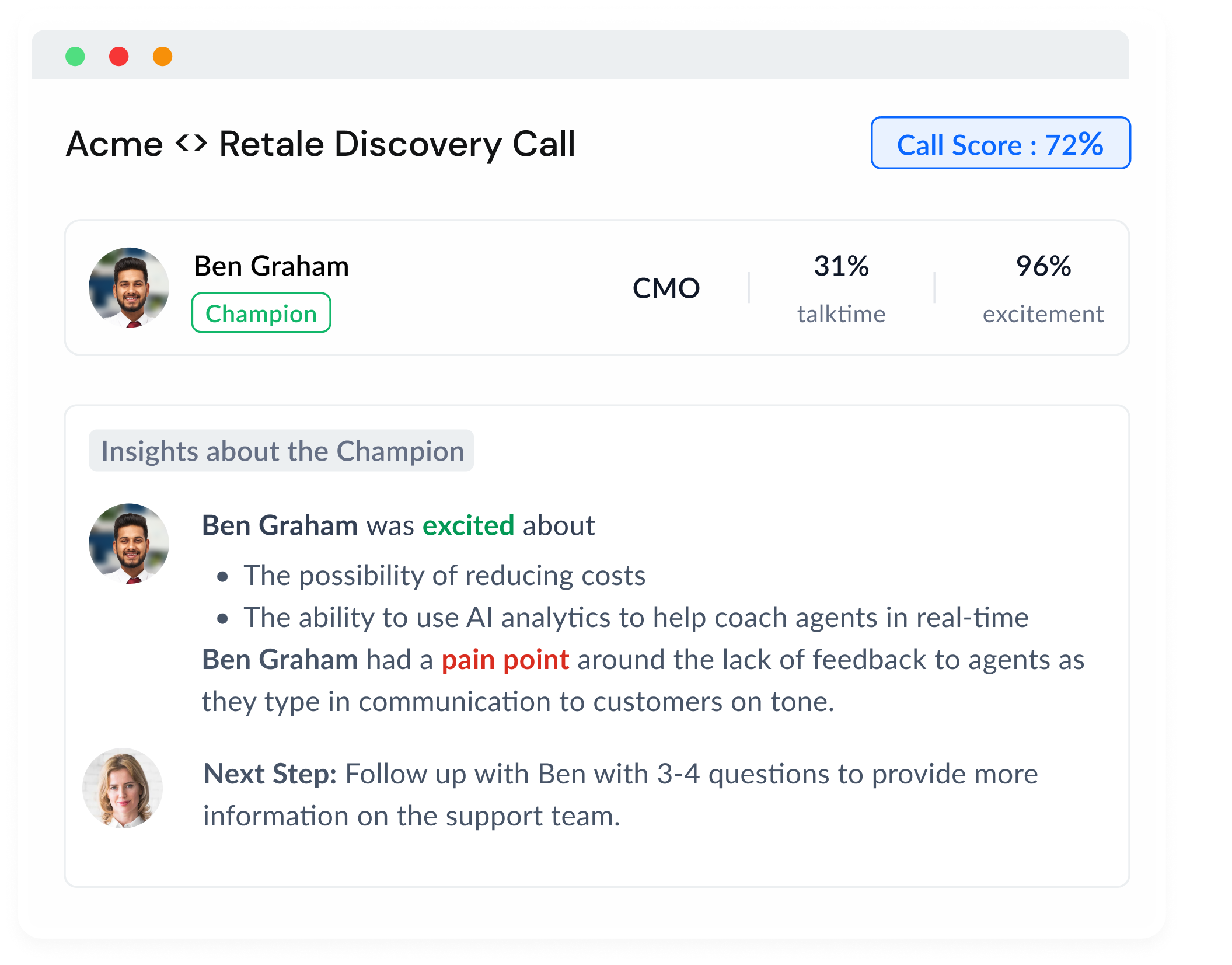If your prospect feels that you don’t care about them, they aren’t signing a deal with you.
If they feel that you are not trustworthy, they aren’t signing a deal with you.
You don’t have multiple interactions or hours' worth of time to build rapport.
You need to do that quickly, within minutes.
According to sales expert and author Josiane Feigon, only 13% of customers believe that a sales rep actually understands their needs.
The solution to the challenge of open communication and empathy turns out to be simpler than you think. And a big part of it is mirroring.
Mirroring forms an essential part of your active listening toolkit as a sales professional. People spend as much as 55% of their time at the workplace listening. Mirroring acts to demonstrate to the speaker that they are heard,seen and being listened to. And that is a very fundamental human need, sales calls, workplaces or elsewhere.
What is Mirroring And How Does it Work in Sales Communication?
Simply put, mirroring is a communication technique that humans use - sometimes, even inadvertently - to build an environment of trust and empathy and drive conversations toward meaningful outcomes. Over the years, mirroring has become an integral communication technique in sales, business negotiations and various other contexts. Even the FBI uses it, and I found that rather interesting. More on this later.
Mirroring, also called isopraxism, is the act of imitating behavior. Mirroring derives its power from one basic fact: We fear what’s different, and we’re drawn to the familiar.
Wall Street Journal reported some years ago that retail sales professionals coached on mirroring verbal and non-verbal behaviors sold more products. Customers who worked with these salespeople mirroring them, left with a more positive opinion of the store.
Yet another experiment published in the Journal of Experimental Social Psychology had students negotiating with each other. Those engaging in mirroring during these negotiations reached a settlement over two third of the time. Those who didn’t missed even the 15% mark for reaching settlements.
These numbers on mirroring mean something to sales professionals. Every sales conversation is an opportunity to build a rapport, get the customer closer to the deal, negotiate efficiently, and, when all goes well, close the deal.
And that makes mirroring a vital skill for sales professionals.
Chris Voss and the Story of a Bank Robbery and Mirroring
A typical sales call without mirroring goes something like this:
- We use logic to try to persuade the other party
- We have prepared answers to objections
- We rely on rational arguments to get to the next step
If only human communication and human psychology were that simple. The problem with this square-box sales communication approach is that it relies on a seemingly reasonable but fatally flawed assumption that humans are logic-driven, rational creatures. The reality is that humans are emotional, instinctive, and reactive–no matter how composed or buttoned-up they appear to be.
In the seminal book, Never Split the Difference, author and former international hostage negotiator for the FBI, Chris Voss, explains how mirroring helped him de-escalate an NYC bank robbery and save hostages. Voss got on the phone with one of the bank robbers, and mirrored his own words to get him to admit his identity.
Voss describes the interaction in the following way:
“The other vehicle’s not out there because you guys chased my driver away . . .” he blurted.
“We chased your driver away?” I mirrored.
“Well, when he seen the police he cut.”
“We don’t know anything about this guy; is he the one who was driving the van?” I asked.
The mirroring continued between me and Watts, and he made a series of damaging admissions. He started vomiting information, as we now refer to it in my consulting business. He talked about an accomplice we had no knowledge of at the time. That exchange helped us nail the driver of the getaway car.
By mirroring Watts’s own admissions, Voss was able to direct the conversation to his own advantage. He explains, “When deliberating on a negotiating strategy or approach, people tend to focus all their energies on what to say or do, but it’s how we are (our general demeanor and delivery) that is both the easiest thing to enact and the most immediately effective mode of influence.”
Mirroring, Explained
While your sales calls won’t look anything like a bank robbery (at least, we hope not), mirroring can help you put your prospects at ease, dismantle their objections, and convince them that you genuinely care about their success.
Examples of mirroring can include:
- Smiling when the other person smiles
- Laughing along with the other person
- Using hand gestures in response to the other person’s hand gestures
- Adjusting your volume to the other person’s volume (e.g. speaking in a softer voice)
- Repeating the same words back to the person
- Nodding when the person nods
- Adopting a warm, friendly tone or a more serious, formal tone in response to the other person’s tone
While this may sound like a game of “Simon Says,” mirroring actually comes across as quite natural. It’s simply a way to communicate that you are on the same page as the other person through verbal and non-verbal cues.
Why Does Mirroring Work?
Like we all agree, humans are more reactive and emotional than we like to admit. We also have more biases, or tendencies or prejudices towards certain people or ideas.
One of the biases that affects us the most in a professional context is a bias towards familiarity. We like what’s familiar or known… especially when investing our money into something. When someone seems to be unfamiliar, we are more likely to be threatened by their intentions, who they are, and what they want from us.
“It’s not human nature to embrace the unknown. It scares us. When we are confronted by it, we ignore it, we run away, or we label it in ways that allow us to dismiss it,” explains Chris Voss.
Mirroring, however, can help you overcome biases in your prospects by using both verbal and nonverbal communication to show them you are on their side. In Never Split the Difference, Voss uses an example of using the word “stewardship” (a word associated with Christianity) with a client who appears to be a born-again Christian. By mirroring the client’s religious faith, Voss was able to communicate that he understood him.
How to use Mirroring in a Sales Call
There are several ways to mirror someone you’re interacting with in a sales call. Strategies will vary depending on context. For example, if you’re on a video call, you’ll be able to use facial expressions and body language to mirror your prospect. If you’re on an audio call, you’ll be limited to using verbal cues to mirror your prospect.
Here are five strategies for effective mirroring.
Sales Mirroring Technique 1: Use the Three-Word Trick
In Never Split the Difference, Chris Voss talks about the power of simply repeating three words back to the other person. Those can include the last three words of what someone just said, or the most important three words of what someone just said.
For example:
Sales Pro: “How is your current product management system working for you?”
Prospect: “It’s working pretty well.”
Sales Pro: “Your current system is working well?”
By repeating back the same idea to the prospect, you prompt them to continue explaining a thought. Most people would respond to the above statement by diving more into how their current system is working for them, or introduce any concerns that they have with it.
“Yeah, it’s been working well except that it doesn’t yet integrate with our CRM…”
Sales Mirroring Technique 2: Mimic Facial Expressions
When your prospect smiles, smile. When they nod slowly, nod back. While this may sound unnatural, it’s actually a very natural part of interaction between both humans and animals. It’s a part of what’s called the “mirror neuron system” in our brains, and it’s a critical part of feeling and expressing empathy.
Some part of this mirroring is done by us automatically, but much of it, like smiling and showing interest, is within our control.
You can also leverage the natural tendency of a human to mirror you by showing a positive and interested demeanor so that the prospect also tends to be positive and interested. This video demonstrates how you can use mirroring in an interaction to both respond and “set the tone” in an interview.
Sales Mirroring Technique 3: Mirror Body Language
Body language is one of the most important parts of communication. It helps to decode the true mood, intent, and response of the other person. For example, crossed arms may signify resistance, while a nodding head signifies agreement and engagement. While on a video call, pay attention to the body language of your prospect and mimic when appropriate.
If your prospect has a rushed demeanor, it might make sense for you to go a bit quickly as well - as long as they continue to engage with you properly. In the right contexts, this would ensure the prospect that you value that they are strapped for time and would make sure to cover more ground in less time.
Sales Mirroring Technique 4: Match Tonality and Volume
Seek to match the tone and volume of your prospect’s voice. If they’re speaking in softer, quieter tones, avoid coming on too strong with a loud, blustery voice.
Like mirroring body language, tone and volume mirroring makes the prospect feel that you understand where they are coming from. It also helps them feel like they are talking to someone with similar modes of interaction or personality as themselves.
Sales Mirroring Technique 5: Change Your Attitude
Finally, make an effort to mirror the attitude of your prospect. You’re not trying to change their mood; you’re entering their space and building a connection. If your prospect is feeling chipper and outgoing, then you can match them. But if they are behaving in a more formal manner, match their attitude and make an effort to match language and tone.
Don’t Forget: It’s Not Just Mimicking, It’s About Empathy
Genuine empathy is essential to effective mirroring. If you don’t actually care about your prospect’s needs and challenges, mirroring techniques simply won’t work. Remember that mirroring is not a tactic to get your prospect to comply with your agenda. It’s a practice that can foster a safe space for authentic communication and open-mindedness during a sales call.
And with Sybill, that’s precisely what we are trying to build for sales professionals and prospects. It supports engagement with your prospect and helps you get further insight into what they’re actually thinking.
Using behavior AI, Sybill tracks and analyzes the nuanced facial expressions and body language of your sales prospect on a video call.
With Sybill, you can actually see how often you and your prospect smiled or nodded together, and how that changed their mood. You can also analyze how well you're doing in terms of building rapport using mirroring by tracking this behavior across calls taken by you or your teammates. You can also rewatch the questions asked and see if you used mirroring properly, and/or identify opportunities where you could have used it, and share the feedback with your team. More than a transcription tool, Sybill gives you complex and useful insight into your sales calls–and can help you learn and perfect the art of mirroring to engage and delight your prospects.
To sign up for Sybill for free, click here.















.png)




